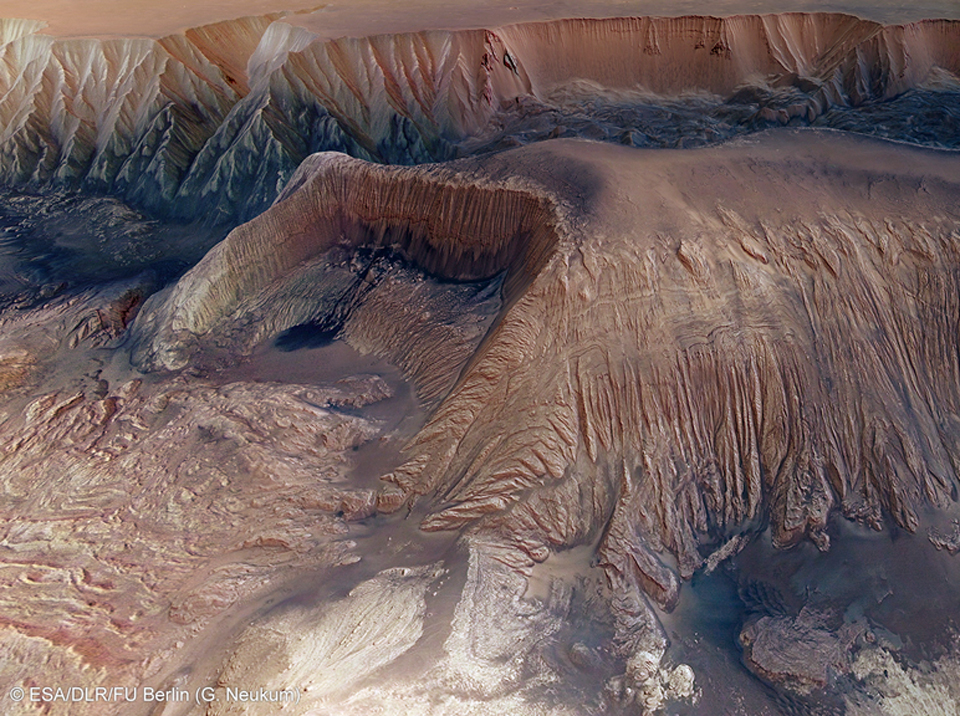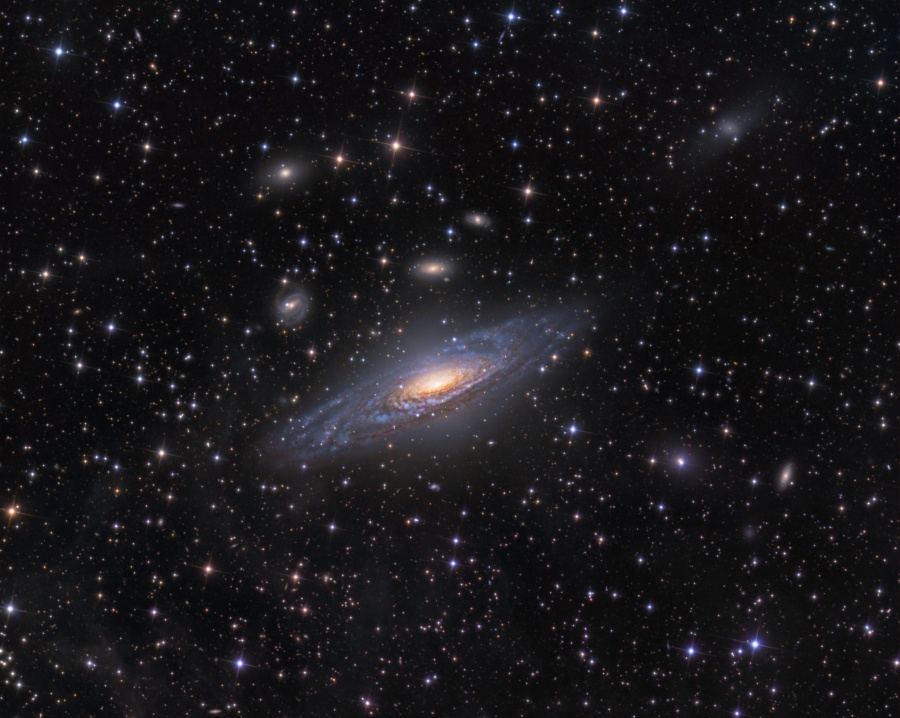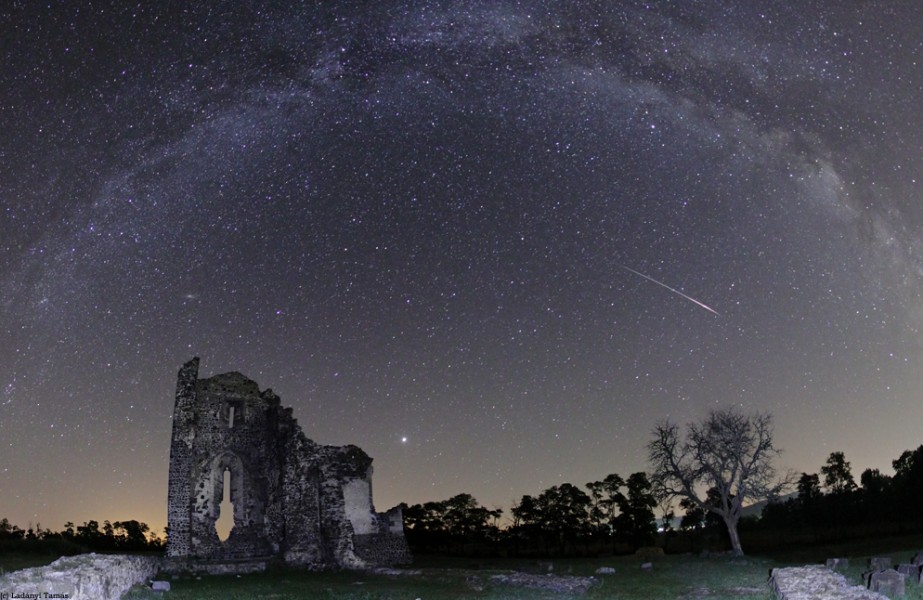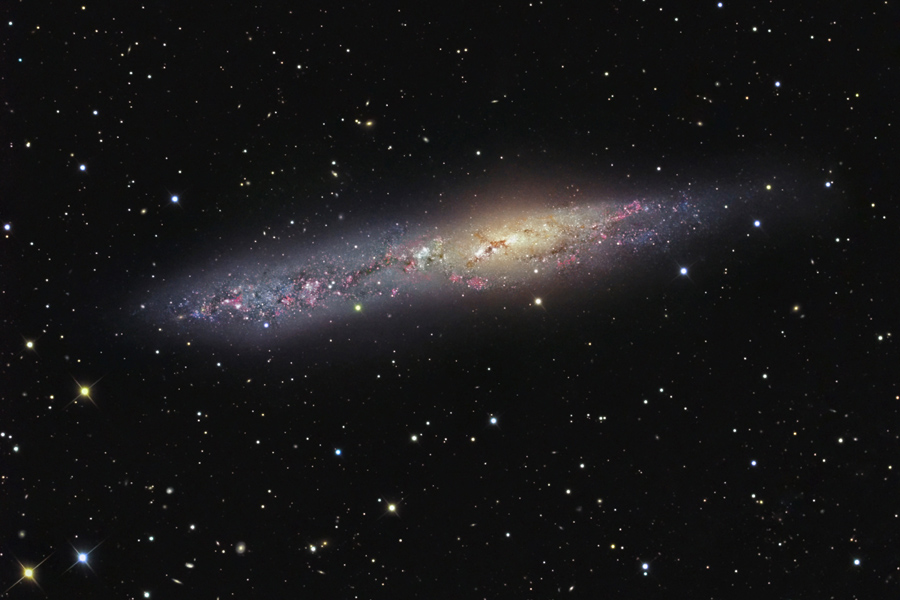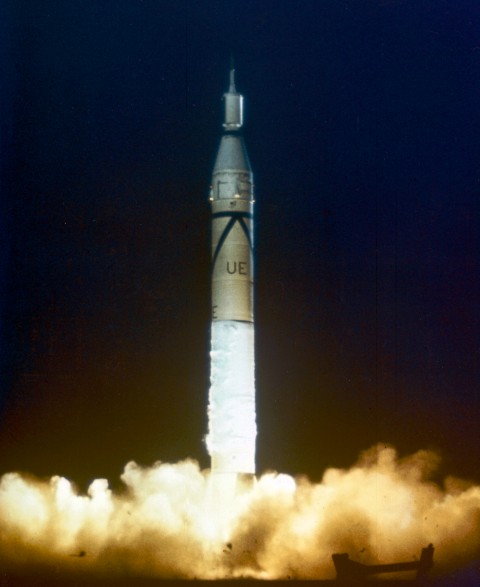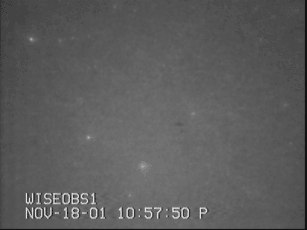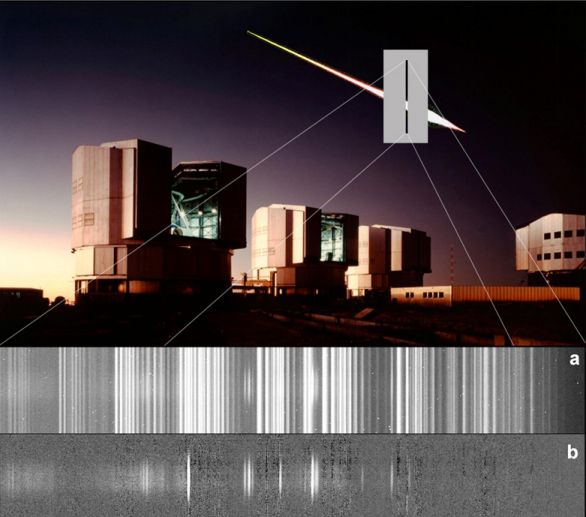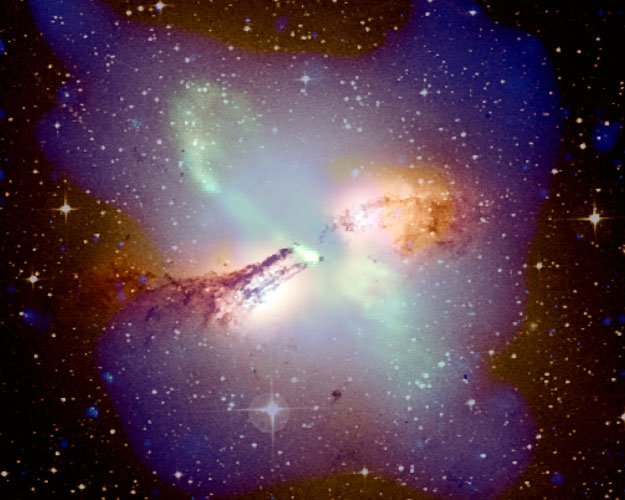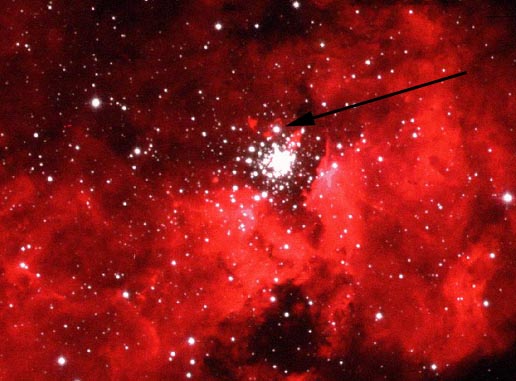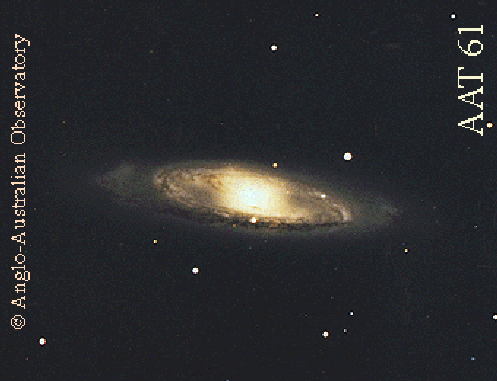| << Previous | Index | Next >> |
2015 Tonight the Perseid Meteor Shower reaches its maximum. Grains of icy rock will streak across the sky as they evaporate during entry into Earth's atmosphere. These grains were shed from Comet Swift-Tuttle. The Perseids result from the annual crossing of the Earth through Comet Swift-Tuttle's orbit, and are typically the most active meteor shower of the year. Although it is hard to predict the level of activity in any meteor shower, in a clear dark sky an observer might see a meteor a minute. This year's Perseids occur just before a new Moon and so the relatively dark sky should make even faint meteors visible. Meteor showers in general are best be seen from a relaxing position, away from lights. Featured here is a meteor caught exploding two weeks ago above Austria next to the central band of our Milky Way Galaxy.
2014 What's happened in Hebes Chasma on Mars? Hebes Chasma is a depression just north of the enormous Valles Marineris canyon. Since the depression is unconnected to other surface features, it is unclear where the internal material went. Inside Hebes Chasma is Hebes Mensa, a 5 kilometer high mesa that appears to have undergone an unusual partial collapse -- a collapse that might be providing clues. The above image, taken by the robotic Mars Express spacecraft currently orbiting Mars, shows great details of the chasm and the unusual horseshoe shaped indentation in the central mesa. Material from the mesa appears to have flowed onto the floor of the chasm, while a possible dark layer appears to have pooled like ink on a downslope landing. A recent hypothesis holds that salty rock composes some lower layers in Hebes Chasma, with the salt dissolving in melted ice flows that drained through holes into an underground aquifer.
2013 Are asteroids dangerous? Some are, but the likelihood of a dangerous asteroid striking the Earth during any given year is low. Because some past mass extinction events have been linked to asteroid impacts, however, humanity has made it a priority to find and catalog those asteroids that may one day affect life on Earth. Pictured above are the orbits of the over 1,000 known Potentially Hazardous Asteroids (PHAs). These documented tumbling boulders of rock and ice are over 140 meters across and will pass within 7.5 million kilometers of Earth -- about 20 times the distance to the Moon. Although none of them will strike the Earth in the next 100 years -- not all PHAs have been discovered, and past 100 years, many orbits become hard to predict. Were an asteroid of this size to impact the Earth, it could raise dangerous tsunamis, for example. Of course rocks and ice bits of much smaller size strike the Earth every day, usually pose no danger, and sometimes creating memorable fireball and meteor displays.
2012 This galaxy is having a bad millennium. In fact, the past 100 million years haven't been so good, and probably the next billion or so will be quite tumultuous. Visible on the upper left, NGC 4038 used to be a normal spiral galaxy, minding its own business, until NGC 4039, toward its right, crashed into it. The evolving wreckage, known famously as the Antennae, is pictured above. As gravity restructures each galaxy, clouds of gas slam into each other, bright blue knots of stars form, massive stars form and explode, and brown filaments of dust are strewn about. Eventually the two galaxies will converge into one larger spiral galaxy. Such collisions are not unusual, and even our own Milky Way Galaxy has undergone several in the past and is predicted to collide with our neighboring Andromeda Galaxy in a few billion years. The frames that compose this image were taken by the orbiting Hubble Space Telescope by professional astronomers to better understand galaxy collisions. These frames -- and many other deep space images from Hubble -- have since been made public, allowing an interested amateur to download and process them into this visually stunning composite.
2011 Big, beautiful spiral galaxy NGC 7331 is often touted as an analog to our own Milky Way. About 50 million light-years distant in the northern constellation Pegasus, NGC 7331 was recognized early on as a spiral nebula and is actually one of the brighter galaxies not included in Charles Messier's famous 18th century catalog. Since the galaxy's disk is inclined to our line-of-sight, long telescopic exposures often result in an image that evokes a strong sense of depth. The effect is further enhanced in this sharp image by galaxies that lie beyond the gorgeous island universe. The background galaxies are about one tenth the apparent size of NGC 7331 and so lie roughly ten times farther away. Their close alignment on the sky with NGC 7331 occurs just by chance. Seen here through faint foreground dust clouds lingering above the plane of Milky Way, this visual grouping of galaxies is also known as the Deer Lick Group.
2010 Each August, as planet Earth swings through dust trailing along the orbit of periodic comet Swift-Tuttle, skygazers can enjoy the Perseid Meteor Shower. The shower should build to its peak now, best seen from later tonight after moonset, until dawn tomorrow morning when Earth moves through the denser part of the wide dust trail. But shower meteors have been spotted for many days, like this bright Perseid streaking through skies near Lake Balaton, Hungary on August 8. In the foreground is the region's Church of St. Andrew ruin, with bright Jupiter dominating the sky to its right. Two galaxies lie in the background of the wide-angle, 3 frame panorama; our own Milky Way's luminous arc, and the faint smudge of the more distant Andromeda Galaxy just above the ruin's leftmost wall. If you watch for Perseid meteors tonight, be sure and check out the early evening sky show too, featuring bright planets and a young crescent Moon near the western horizon after sunset.
2009 Irregular galaxy NGC 55 is thought to be similar to the Large Magellanic Cloud (LMC). But while the LMC is about 180,000 light-years away and is a well known satellite of our own Milky Way Galaxy, NGC 55 is more like 6 million light-years distant and is a member of the Sculptor Galaxy Group. Classified as an irregular galaxy, in deep exposures the LMC itself resembles a barred disk galaxy. However, spanning about 50,000 light-years, NGC 55 is seen nearly edge-on, presenting a flattened, narrow profile in contrast with our face-on view of the LMC. Just as large star forming regions create emission nebulae in the LMC, NGC 55 is also seen to be producing new stars. This highly detailed galaxy portrait highlights a bright core crossed with dust clouds, telltale pinkish star forming regions, and young blue star clusters in NGC 55.
2008 If you could stand on Mars, what would you see? The robotic Phoenix spacecraft that just landed on Mars in May recorded the above spectacular panorama. The above image is actually a digital combination of over 100 camera pointings and surveys fully 360 degrees around the busy robotic laboratory. Clicking on the horizontally compressed image above will bring up the extra-wide uncompressed version. Visible in the image foreground are circular solar panels, various Phoenix instruments, rust colored rocks, a trench dug by Phoenix to probe Mars' chemical composition, a vast plateau of dirt and dirt-covered ice, and, far in the distance, the dust colored atmosphere of Mars. Phoenix landed in the far north of Mars and has been using its sophisticated laboratory to search for signs that past life might have been possible. Recent soil analyses have confirmed the presence of ice, but gave conflicting indications of unexpected perchlorate salts. Whether perchlorates exist on Mars is now being aggressively researched, as well as what effects perchlorates might have had on the past development of life.
2007 Tonight is a good night to see meteors. Comet dust will rain down on planet Earth, streaking through dark skies in the annual Perseid meteor shower. While enjoying the anticipated space weather, astronomer Fred Bruenjes recorded a series of many 30 second long exposures spanning about six hours on the night of 2004 August 11/12 using a wide angle lens. Combining those frames which captured meteor flashes, he produced this dramatic view of the Perseids of summer. Although the comet dust particles are traveling parallel to each other, the resulting shower meteors clearly seem to radiate from a single point on the sky in the eponymous constellation Perseus. The radiant effect is due to perspective, as the parallel tracks appear to converge at a distance. Bruenjes notes that there are 51 Perseid meteors in the composite image, including one seen nearly head-on. This year, the Perseids Meteor Shower is expected to peak after midnight tonight, in the moonless early morning hours of August 12.
2006 Inaugurating the era of space exploration for the US, the First Explorer, a thirty pound satellite, was launched into Earth orbit on January 31, 1958 by the Army Ballistic Missile Agency. Explorer I carried instruments to measure temperatures, micrometeorite impacts, and an experiment designed by James A. Van Allen to measure the density of electrons and ions in space. The measurements made by Van Allen's experiment led to an unexpected and startling discovery -- an earth-encircling belt of high energy electrons and ions trapped in the magnetosphere now known as the Van Allen Radiation Belt. Explorer I ceased transmitting on February 28 of that year but remained in orbit until March of 1970. Pioneering astrophysicist James Van Allen died on August 9th at the age of 91.
2005
2004 Chasing the brief flash of a meteor trail across the sky with a very large telescope is a nearly impossible task. But on May 12, 2002, astronomers got lucky, as a bright meteor chanced across the narrow slit of their spectrograph at the Paranal Observatory. At the time, the spectrograph was being used to study the light from a supernova, separating and recording the many near-infrared emission lines produced by atoms in the distant stellar explosion. Below this artistic montage of a meteor streak and Very Large Telescope units at Paranal, panel a shows the near-infrared sky background spectrum and the May 12 meteor combined. Panel b shows the emission spectrum of the meteor alone, after subtracting away the background contributions. The meteor emission is due to colliding oxygen and nitrogen atoms and molecules in the superheated air along the glowing trail at an altitude of about 100 kilometers.
2003 Stephan's Quintet is a picturesque but clearly troubled grouping of galaxies about 300 million light-years away toward the high-flying constellation Pegasus. Spanning over 200,000 light-years at that distance, this composite false-color image illustrates the powerful nature of this multiple galaxy collision, showing x-ray data from the Chandra Observatory in blue superposed on optical data in yellow. The x-rays from the central blue cloud running vertically through the image are produced by gas heated to millions of degrees by an energetic shock on a cosmic scale. The shock was likely the result of the interstellar gas in the large spiral galaxy, seen immediately to the right of the cloud, colliding with the quintet's tenuous intergalactic gas as this galaxy plunged through group's central regions. In fact, over billions of years, repeated passages of the group galaxies through the hot intergalactic gas should progressively strip them of their own star forming material. In this view, the large spiral galaxy just seen peeking above the bottom edge is an unrelated foreground galaxy a mere 35 million light-years distant.
2002
2001 Star forming regions known as "EGGs" are uncovered at the end of this giant pillar of gas and dust in the Eagle Nebula (M16). EGGs, short for evaporating gaseous globules, are dense regions of mostly molecular hydrogen gas that fragment and gravitationally collapse to form stars. Light from the hottest and brightest of these new stars heats the end of the pillar and causes further evaporation of gas - revealing yet more EGGs and more young stars. This picture was taken by the Wide Field and Planetary Camera on board the Hubble Space Telescope.
2000 This weekend, the annual Perseid Meteor Shower reaches its maximum. Grains of cosmic sand and gravel shed from Comet Swift-Tuttle will streak across the sky as they vaporize during entry into Earth's atmosphere. The Perseids result from the yearly crossing of the Earth through Comet Swift-Tuttle's orbit. The Perseids are typically the most active meteor shower of the year. In a clear dark sky, an observer might see a meteor a minute near peak times, but this year a bright moon will overwhelm the glow from many perseid meteors until moonset in the early morning hours. Pictured above is a Perseid meteor from 1993. The colors are representative but digitally enhanced. As the meteor streaked across the night sky, different excited atoms emitted different colors of light. The origin of the green tinge visible at the right is currently unknown, however, and might result from oxygen in Earth's atmosphere. Perseid meteors can best be seen from a relaxing position, away from lights, just before the dawn twilight.
1999 Last October the Space Shuttle Discovery deployed Spartan 201, a spacecraft that monitored the corona of the Sun. Instruments on Spartan 201 were used to estimate the density of electrons emitted into the solar corona, calibrate data from the Solar and Heliospheric Observatory (SOHO) satellite, and study how the Sun is changing as it reaches maximum activity over the next few years. Pictured above, the space shuttle's robot arm (top left) releases Spartan (center) into space. The tail fin of the space shuttle is visible on the right, while the Earth hovers in the background. Spartan floated near the shuttle for two days before it was picked up again and returned to Earth.
1998 Daedalus warned Icarus that if he flew too high, the Sun would melt his wings. Apparently, nobody gave the ERAST Pathfinder-Plus aircraft a similar warning. Earlier this month, not only did Pathfinder-Plus fly higher than any previous propeller-driven aircraft - its wings converted sunlight into power. Pictured, Pathfinder-Plus is flying above Hawaii soon after soaring to a record height of 24,700 meters. What's more, Pathfinder-Plus is only a prototype -- future aircraft in the ERAST program may fly higher. Pathfinder's wings spread nearly 30 meters, and its total mass is only about 270 kilograms. NASA's Pathfinder-Plus is flown by remote control, and can stay aloft for weeks at a time.
1997 No supernova has ever been predicted - yet. These dramatic stellar explosions that destroy stars, that create and disperse the elements that compose people and planets, that light up the night sky, are not so well understood that astronomers can accurately predict when a star will explode - yet. Perhaps Sher 25 will be the first. Sher 25, designated by the arrow, is a blue supergiant star located just outside the open star cluster and ionized region named NGC 3603. Sher 25 lies in the center of an hourglass shaped nebula much like the one that surrounds the last bright supernova visible from Earth: SN1987a. Now the hourglass shaped rings around SN1987a were emitted before that blue supergiant exploded. Maybe Sher 25 has expelled these bipolar rings in a step that closely precedes a supernova. Maybe not. If so, Sher 25 may be within a few thousand years of its spectacular finale.
1996
1995 Space Shuttle Atlantis lands at Edwards Air Force Base in California. The Space Shuttle is the first orbital space vehicle to land on a runway like an airplane. Space Shuttles sometimes have the option of landing in White Sands, New Mexico or at the Shuttle Landing Facility at the Kennedy Space Center in Florida. The runways the shuttles land on are among the longest in the world. Shuttles that do not land in Florida must generally be strapped to the back of a 747 airplane and flown back.
| << Previous | Index | Next >> |

